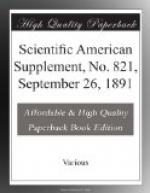[Illustration: Fig. 1]
In the drawings we have shown two receptacles B and only one receptacle A; but we do not wish to confine ourselves to any particular number, nor do we wish to confine ourselves to the horizontal position in which the receptacles are shown.
C is a pipe leading from the receptacle A to a point at or near the bottom of the receptacle B.
F is a pipe through which the mixture of water and liquefied gas from the receptacle B is forced by the expansion of said liquefied gas, the said pipe taking the mixture of water and liquefied gas from the bottom of the receptacle.
[Illustration: Fig. 2]
To use the apparatus, open the stop cock D in the pipe C, leading to one of the receptacles B, whereupon, owing to the lower pressure in the cylinder B, the liquid carbon dioxide expands and rises to the top of the cylinder A and forces the liquid carbon dioxide into the cylinder B, the same as the superior steam of a boiler forces the water of the boiler out when the same is tapped below the surface of the liquid. Now upon opening the tap H, this superior gas forces out the mixture of water and liquid carbon dioxide, which suddenly expanding causes portions of the globules of liquefied gas to be frozen, and these, being protected by a rapidly evaporating portion of the liquefied gas, are thrown on the fire in solid particles. At the same time the water is blown into a spray, which is more or less frozen. The fire is thus rapidly extinguished by the vaporization of the carbon dioxide and water spray.
* * * * *
SMOKELESS GUNPOWDER.
By Hudson Maxim.
During the last forty years leading chemists have continued to experiment with a view to the production of a gunpowder which should be smokeless. But not until the last few years has any considerable degree of success been attained.
To be smokeless, a gunpowder must yield only gaseous products of combustion. None of the so-called smokeless powders are entirely smokeless, although some of them are very nearly so.
The smoke of common black gunpowder is largely due to minute particles of solid matter which float in the air. About one-half of the total products of combustion of black gunpowder of ordinary composition consists of potassium carbonate in a finely divided condition and of potassium sulphate, which is produced chiefly by the burning in the air of potassium sulphide, another production of combustion, as on the outrushing gases it is borne into the air in a fine state of division.
Another cause for the smoke of gunpowder is the formation of small liquid vesicles which condense from some of the products of combustion thrown into the air in a state of vapor, in the same manner as vesicles of aqueous vapor form in the air on the escape of highly heated steam from the whistle of a locomotive.




